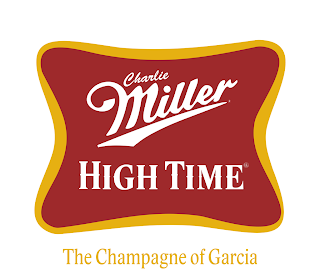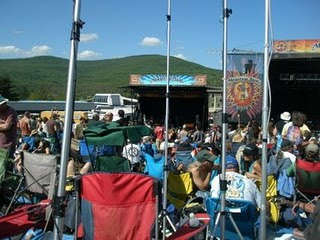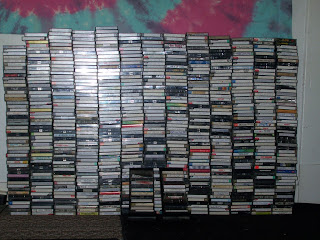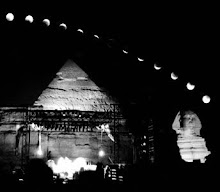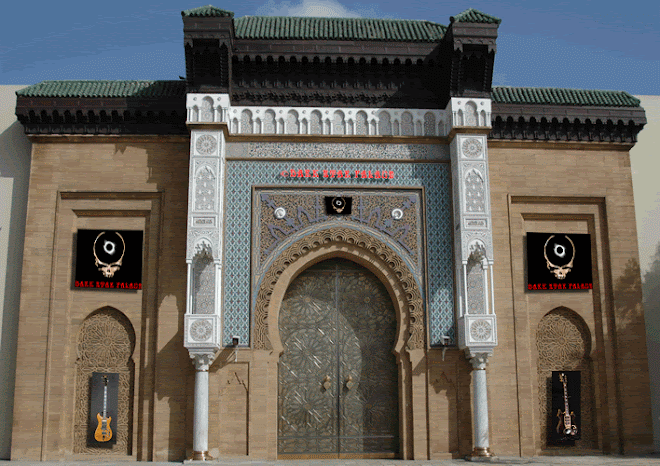Artifact(s) of the Week: Charlie Miller Interview, Photos & Studio Tour
 |
| Charlie and Rango with a box of Rango's masters |
Charlie is renown in trading circles for his amazing ongoing upgrades and remasters of Grateful Dead soundboard and audience tapes that had formerly resided in the depths of only the most hardcore Dead collections. Charlie is one of the great liberators of these tapes, and he has shown amazing generosity to the Dead community to donate his time, expertise and gear to make every Deadhead's listening session a more enjoyable and magical experience. While his day job is being the recording engineer and archivist for ace guitarist Steve Kimock, Charlie always seems to find the time during his Deadhead remastering night job to rework and upload yet another amazing piece of the Grateful Dead's audio history into the greater Internet trading community. If there were a Grateful Dead Nobel Peace Prize, Dark Star Palace would have Mr. Miller at the top of our short list. Ok! Now, it's Miller Time!!
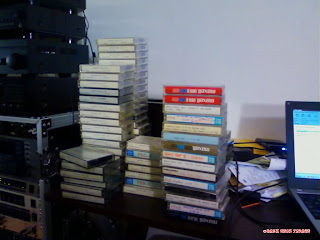 |
| Piles of Joani Walker masters in Charlie's studio awaiting remastering |
Charlie Miller: Thanks for having me here.
 |
| Dan Healy's Soundboard Cassette Masters |
CM: Well, as for many of us, it was the album Live Dead. Sometime during the summer of 1977, my friend forced me to listen to one side of Live Dead. He played me Saint Stephen > The Eleven. I didn’t like it so he played it again. I started to get it so he then played me Dark Star. That summer, I slowly started to collect their albums. When I heard Eyes Of The World from Wake Of The Flood, I was hooked.
DSP: What about taping? If my Dark Star Palace spys are correct, you first started taping at the April 15, 1983 Rochester show. You first rolled tape on "Shakedown"! You also got a rarity on your first tape: "Maybe You Know How I Feel." Tell us about that first show and how you became a taper.
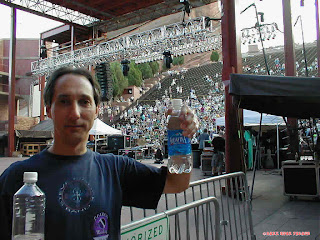 |
| Charlie on stage at Red Rocks for Ratdog |
DSP: After the Rochester show, did you know that you wanted to be a serious taper going forward?
CM: Absolutely. No doubt about it.
DSP: What was your first taping rig?
CM: Absolutely. No doubt about it.
DSP: What was your first taping rig?
 CM: Well, in 1978 my sister and I taped the rock band Boston at Nassau Coliseum with a little hand held recorder. In 1983 when I started taping the Grateful Dead I started off small. There were no taping sections and you still had to sneak your gear in at some venues. I started off with a Sony D6, then eventually upgraded to a Sony D5. For the first few years I was just patching out of other people’s rigs, but I knew enough to pick out the good mics. I eventually bought a 4 channel mic mixer with a pair of Naks and a pair of AKG’s.
CM: Well, in 1978 my sister and I taped the rock band Boston at Nassau Coliseum with a little hand held recorder. In 1983 when I started taping the Grateful Dead I started off small. There were no taping sections and you still had to sneak your gear in at some venues. I started off with a Sony D6, then eventually upgraded to a Sony D5. For the first few years I was just patching out of other people’s rigs, but I knew enough to pick out the good mics. I eventually bought a 4 channel mic mixer with a pair of Naks and a pair of AKG’s. CM: It was trial and error. I would take notice as to how certain mics sounded in certain venues and grow from there.
DSP: Did you experiment with various mics, thinking "oh, these Beyer M160s really smooth over the treble at outdoor shows" or move to Neumann condensers so you could capture more detail on tape, etc?
CM: Exactly. There was a certain sound I liked and I knew how to get it. Once I started taping digitally, that all changed and I pretty much had to start over again, using what I had learned on dead tour.
DSP: Let's move into your role as a remastering engineer. I see you have just wrapped up some nice remasters of the Kansas and Oklahoma shows from July, 1981. Let's start off with the question that so many Dead freaks have asked over the years...How do you get such great source tapes to work with?
CM: I managed to make friends with the right people. I hooked up with (and worked with) many Grateful Dead band and crew members who have been kind enough to give me access to many tapes. Plus some of my friends were kind enough to help me out, like David Gans, Rob Eaton, Bob Wagner, Paul Scotton and Joani Walker. There are quite a few others, but I don’t think they want their names mentioned.
DSP: When you get source tapes from tapers and traders, do you always insist on getting their original master cassettes, reels, DATs, etc.? Or do you prefer to have them arrive in a pre-determined format.
DSP: Did you experiment with various mics, thinking "oh, these Beyer M160s really smooth over the treble at outdoor shows" or move to Neumann condensers so you could capture more detail on tape, etc?
 |
| Dan Healy's master DAT for 6/13/93 |
DSP: When you get source tapes from tapers and traders, do you always insist on getting their original master cassettes, reels, DATs, etc.? Or do you prefer to have them arrive in a pre-determined format.
CM: It is always best to work with the masters, or as close to the master as possible, but sometimes you don’t have a choice and you get what you get.
DSP: How do you deal with the issue of different tape formats, playback decks, Dolby issues, etc.? Do the traders send you a detailed breakdown of how the tapes were recorded?
DSP: What do you think is the best sounding board tape that has come into your hands?
CM: I can't pick a favorite, but I do have some that I prefer over others. I love the boards from fall 1979, plus I just love the sound on Brent’s keyboards in 1983 and 1984. It was a very cool sound. I’m just like everyone else. I love a full sounding recording with a good mix.
DSP: Let's talk audio processing. Do you prefer to use analog or digital for your EQ and compression choices? Or do you prefer skip this entirely and to do flat transfers?
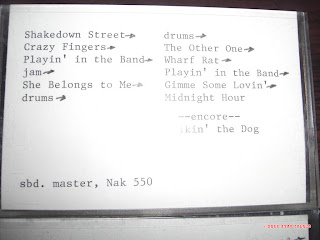 |
| Joani Walker's 11/21/85 Soundboard cassette master |
DSP: Did you ever do any experiments with analog EQs and say...OK, the Dead's console of choice was a 80-series Neve, so I should use 1073 EQs for all my frequency tweaks. Or even geekier.. "I've got a 6/75 tape here from Weir's home studio from the Blues For Allah sessions and since the Dead were using API 312 preamps and 550a EQs for these sessions, I should use those circuits for the transfer. And for this 7/66 Fillmore show, since Bear recorded with a tube Ampex MX-10, I should use that same tube circuit for this specific transfer"?
 |
| Charlie Miller's digital workstation |
DSP: I know that digital conversion has come a long way in recent years...to the point that we are seeing remasters done just for the sake of better A/D transfers. Have you found this to be true with your remastering of Grateful Dead tapes?
CM: Absolutely. I have re-transferred over 100 tapes for this reason. I am currently using the A>D converter on my Sound Devices 744T.
DSP: Does that basically mean that Deadheads will see an entire overhaul of all your old remasters?
CM: Well, I’ve already redone a lot of them, and I’m sure there will be more, when time permits.CM: Absolutely. I have re-transferred over 100 tapes for this reason. I am currently using the A>D converter on my Sound Devices 744T.
DSP: Does that basically mean that Deadheads will see an entire overhaul of all your old remasters?
DSP: What is the most amount of times you have remastered a single show? Three times?
CM: There was one show that I kept redoing due to various reasons (I didn’t catch mistakes). I don’t remember what it was, but it was more than three times.
DSP: How do you think you ended up being the Grateful Dead taping / trading community's remastering guru of choice?
DSP: How do you think you ended up being the Grateful Dead taping / trading community's remastering guru of choice?
CM: I don’t think I’m the community guru. I’m more of the community pain in the ass. I just have a lot of free time due to my touring schedule with Steve Kimock which gives me a lot of time to work on the recordings. Plus as mentioned earlier, I have a lot of friends who are kind enough to let me work on their recordings.
DSP: For many Deadheads from the 1980's on, David Gans and his "Grateful Dead Hour" was their best source for both quality and quantity of live Grateful Dead music. To this day, I see that you are able to work with him to get better sounding tapes out to the Heads. How did you first hook up with David Gans?
 CM: I first met David very briefly in 1998 at a festival he was playing at, but the following year I was taping a show that he played at and he approached me for a copy of the recording. I started working with him to help get his music circulated to the masses which included me starting the David Gans Trading List. David and I became close friends as the years went on and he grew trust in me. He has allowed me to work on a lot of his Grateful Dead tapes and a lot of the recordings from his shows. I even worked with him on the road. I feel lucky that I can call David my friend. I have also helped him out a lot with supplying music for the GDH.
CM: I first met David very briefly in 1998 at a festival he was playing at, but the following year I was taping a show that he played at and he approached me for a copy of the recording. I started working with him to help get his music circulated to the masses which included me starting the David Gans Trading List. David and I became close friends as the years went on and he grew trust in me. He has allowed me to work on a lot of his Grateful Dead tapes and a lot of the recordings from his shows. I even worked with him on the road. I feel lucky that I can call David my friend. I have also helped him out a lot with supplying music for the GDH.
DSP: I know you have worked with various members of the Grateful Dead over the years. Have they given you any feedback on your remasters?
CM: The only feedback they have given me is on the recordings and mixes I have done for their bands. I learned a lot working for Mickey Hart, but that’s another story.
DSP: Are there any good stories that come to mind about the band members and how they view tapers, tape traders, etc.?
DSP: For many Deadheads from the 1980's on, David Gans and his "Grateful Dead Hour" was their best source for both quality and quantity of live Grateful Dead music. To this day, I see that you are able to work with him to get better sounding tapes out to the Heads. How did you first hook up with David Gans?
 CM: I first met David very briefly in 1998 at a festival he was playing at, but the following year I was taping a show that he played at and he approached me for a copy of the recording. I started working with him to help get his music circulated to the masses which included me starting the David Gans Trading List. David and I became close friends as the years went on and he grew trust in me. He has allowed me to work on a lot of his Grateful Dead tapes and a lot of the recordings from his shows. I even worked with him on the road. I feel lucky that I can call David my friend. I have also helped him out a lot with supplying music for the GDH.
CM: I first met David very briefly in 1998 at a festival he was playing at, but the following year I was taping a show that he played at and he approached me for a copy of the recording. I started working with him to help get his music circulated to the masses which included me starting the David Gans Trading List. David and I became close friends as the years went on and he grew trust in me. He has allowed me to work on a lot of his Grateful Dead tapes and a lot of the recordings from his shows. I even worked with him on the road. I feel lucky that I can call David my friend. I have also helped him out a lot with supplying music for the GDH.DSP: I know you have worked with various members of the Grateful Dead over the years. Have they given you any feedback on your remasters?
CM: The only feedback they have given me is on the recordings and mixes I have done for their bands. I learned a lot working for Mickey Hart, but that’s another story.
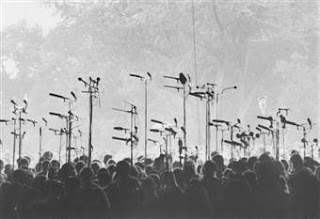 CM: Well, I’ve received some very unpleasant remarks from John Cutler about Deadhead Tapers. As for band members, in 2006 I was hired to do the recording for the Rhythm Devils (Mickey Hart, Billy Kreutzmann, Steve Kimock and Mike Gordon). Mickey told me to record everything. We were at Trey’s barn in Vermont for rehearsals and I had mics set up everywhere doing a multi-track recording (to be mixed down later). At one point when they took a break, I grabbed some mics and my deck and followed them around while they chatted. It was kinda funny following Mickey around with the mics. He said some very funny stuff. At one point they were discussing Sugaree. Mickey was telling Kimock where to play the big solo. I tried my best to keep my mouth shut, but he had it wrong. I stood up and corrected him as to where the big solo goes. Mickey went to disagree with me and Kimock jumped in and said something about never arguing with a taper, that we knew the music better than anyone.
CM: Well, I’ve received some very unpleasant remarks from John Cutler about Deadhead Tapers. As for band members, in 2006 I was hired to do the recording for the Rhythm Devils (Mickey Hart, Billy Kreutzmann, Steve Kimock and Mike Gordon). Mickey told me to record everything. We were at Trey’s barn in Vermont for rehearsals and I had mics set up everywhere doing a multi-track recording (to be mixed down later). At one point when they took a break, I grabbed some mics and my deck and followed them around while they chatted. It was kinda funny following Mickey around with the mics. He said some very funny stuff. At one point they were discussing Sugaree. Mickey was telling Kimock where to play the big solo. I tried my best to keep my mouth shut, but he had it wrong. I stood up and corrected him as to where the big solo goes. Mickey went to disagree with me and Kimock jumped in and said something about never arguing with a taper, that we knew the music better than anyone.DSP: I'm actually surprised the band never hired you! Now that I think of it, why the hell hasn't Rhino hired you yet to help them finally get the Dead's vault 100% remastered and released?
CM: There’s a lot of things about Rhino that puzzles me.
DSP: Do you have thoughts on how you think the Grateful Dead should be putting out their audio vault? For instance, should they put every show out as FLACs for Heads to download, or do it via membership, or do hi-res 24/192 or SACD surround versions, etc.?
CM: I don’t think that 20 year old cassettes would sell well as hi-res. I think FLAC and mp3 is fine, but geez, they need to pitch correct it first!!!
DSP: Ha! Yes...but at least we know there will be a Miller follow-up after those off-pitch shows come out! So, do you have a favorite remaster where you have said: "Damn! That show sounded horrible when it arrived, but now, hear how it shines!"?
CM: Dick’s Picks of 11/1/85.
CM: Dick’s Picks of 11/1/85.
DSP: What about a favorite Dead show in general?
CM: Oh, you had to ask. Can’t narrow it down, but I could make you a list of the top 10, then tomorrow it would be different.
DSP: OK then, if you had to go back in time to attend one show, which would it be?
CM: Maybe 2/13/70 or 2/14/70 or Europe 72 or May 77 or…….But seriously, I would say something like 10/18/74, 10/19/74 or 1/8/79. I just love the 2nd set to 1/8/79.
DSP: In looking at the your crystal ball, what do you think the Grateful Dead trading community will look like 50 years from now?
CM: The complete GD collection on one 4TB USB stick.
DSP: OK then, if you had to go back in time to attend one show, which would it be?
CM: Maybe 2/13/70 or 2/14/70 or Europe 72 or May 77 or…….But seriously, I would say something like 10/18/74, 10/19/74 or 1/8/79. I just love the 2nd set to 1/8/79.
DSP: In looking at the your crystal ball, what do you think the Grateful Dead trading community will look like 50 years from now?
CM: The complete GD collection on one 4TB USB stick.
DSP: Or going back to the Dead's 1973 flyer, the entire collection on a holographic pyramid that fits in the palm of your hand!! Do you think future Heads will be so spoiled by the quantity of great sounding tapes that they won't take the time to absorb each show like older generations did?
CM: Absolutely. It already happens today.
DSP: Charlie, it has been a real pleasure to dig in like this with you. We look forward to your next remaster and hope to follow up with you for some more great chats down the line..
CM: It was a pleasure talking with you. Feel free to contact me anytime….peace.
For this week's Tape of the Week we have one of Charlie Miller's favorite second sets...1/8/79 at Madison Square Garden. Of course, we have Charlie's remastered stream of this show ready and waiting for Dark Star Palace-folk to check out.
- Tape of the Week: 1/8/79
Until next time at Dark Star Palace!
P.S. For those Dark Star Palace freaks that are lurking down South, be sure to get on over to La Grange, Georgia on 10/5 because Lee Johnson's Dead Symphony #6 is hitting the stage! If you haven't heard this amazing piece of music, check it out. Hopefully, DSP will be sitting down to talk with Lee in the near future. For info on this show, go HERE.
P.S. For those Dark Star Palace freaks that are lurking down South, be sure to get on over to La Grange, Georgia on 10/5 because Lee Johnson's Dead Symphony #6 is hitting the stage! If you haven't heard this amazing piece of music, check it out. Hopefully, DSP will be sitting down to talk with Lee in the near future. For info on this show, go HERE.

